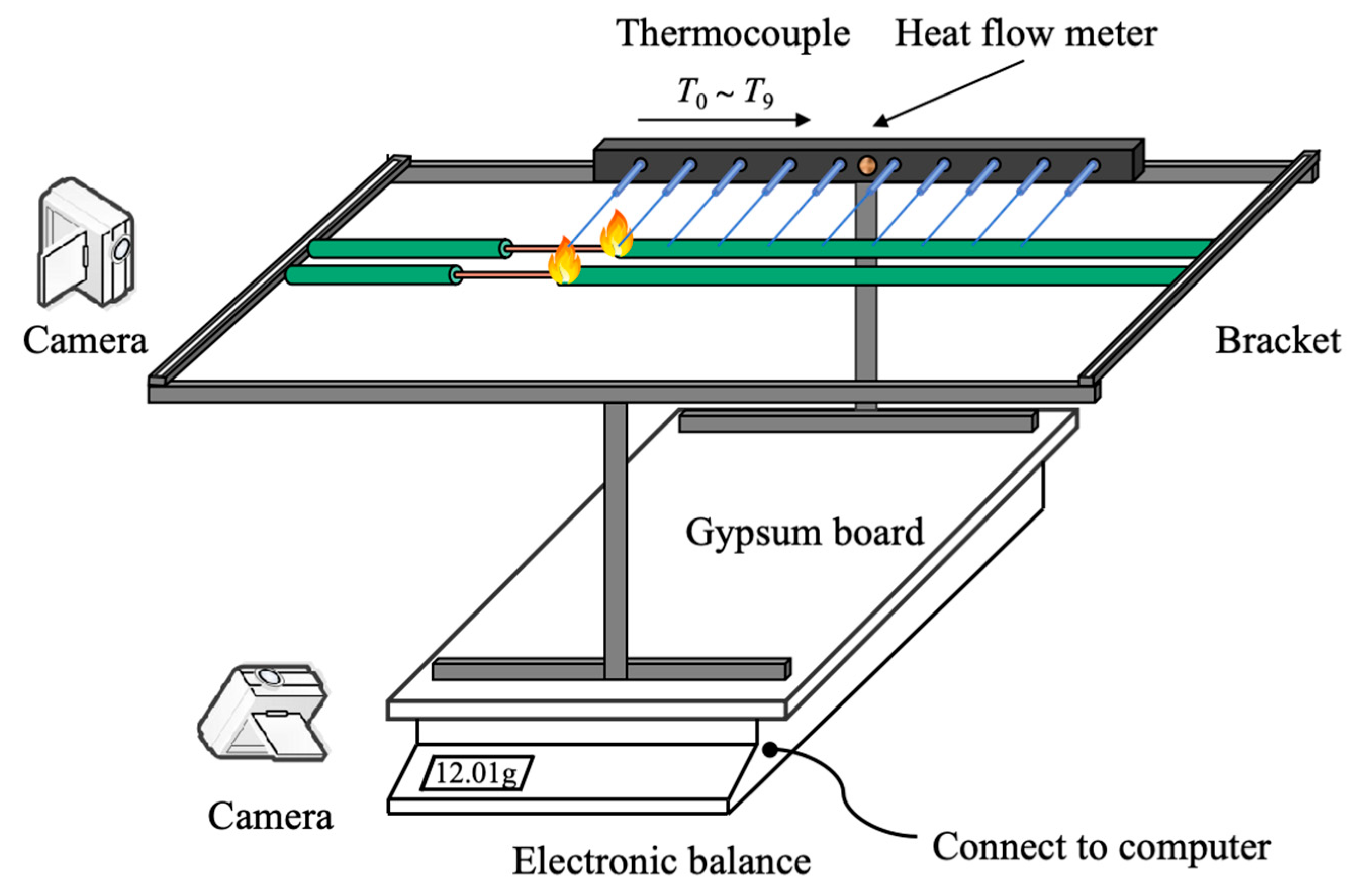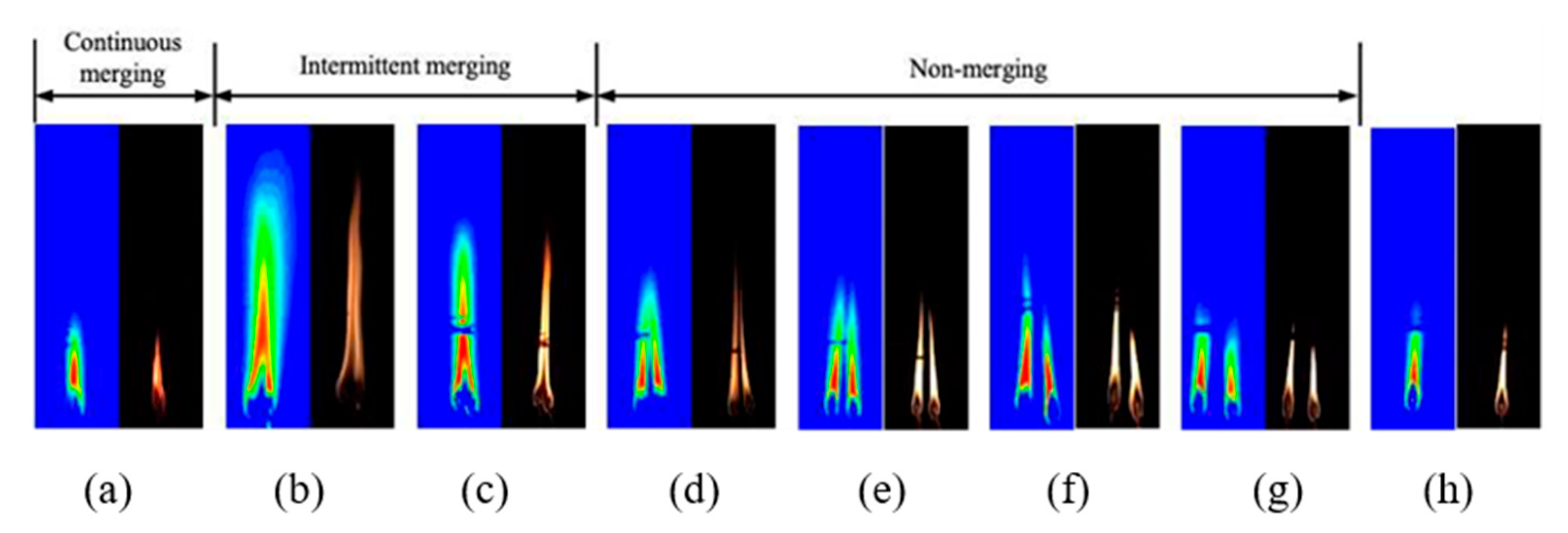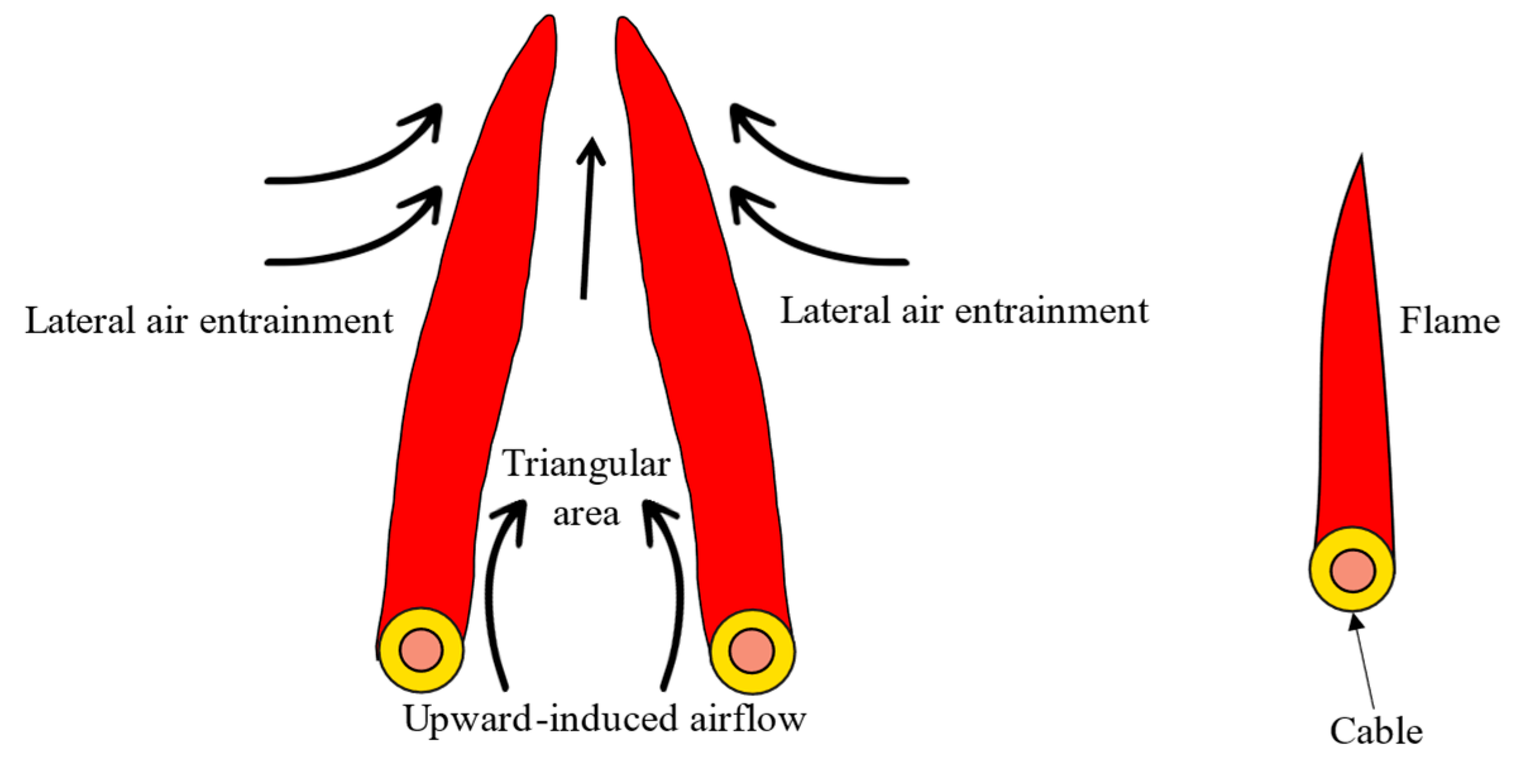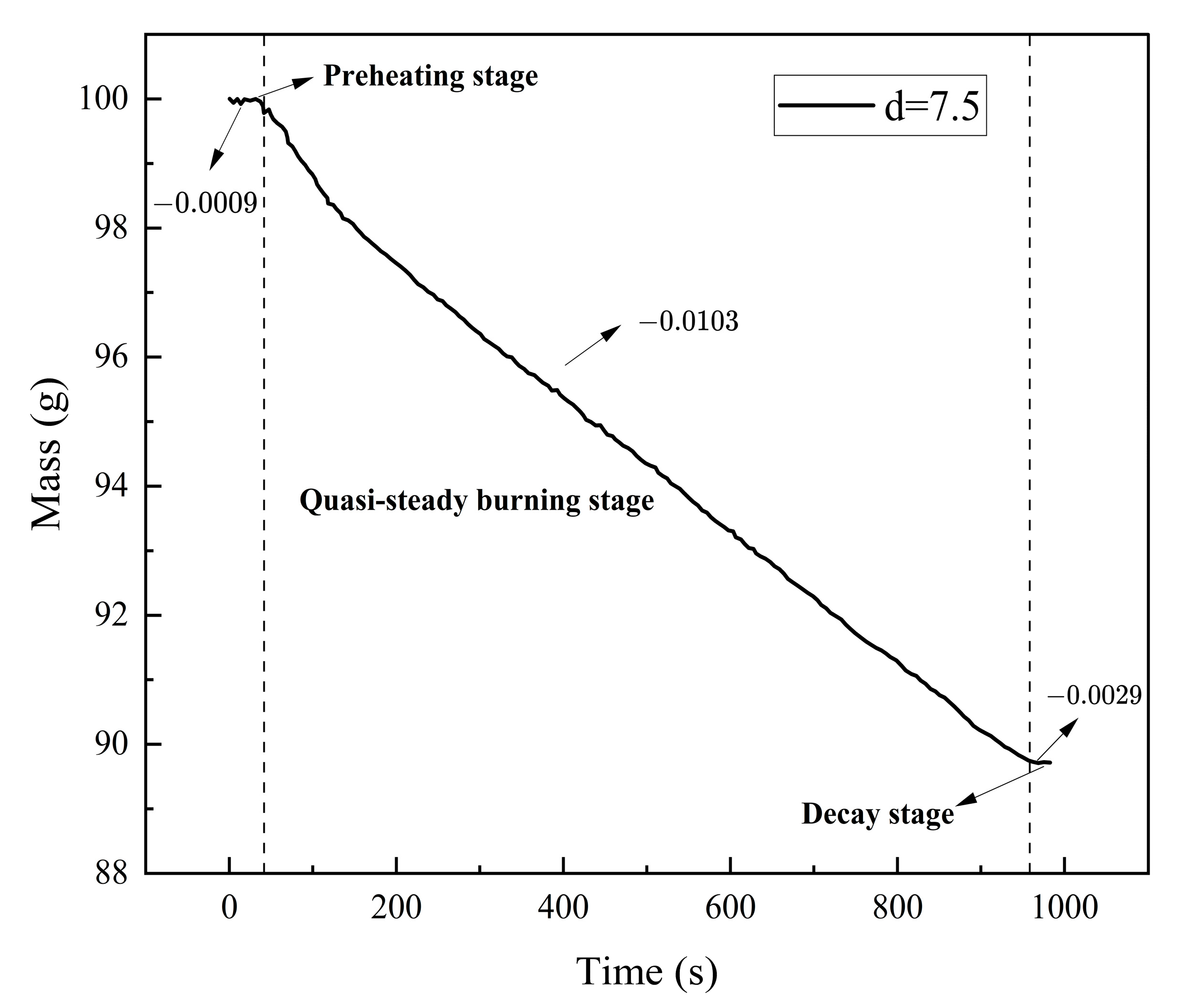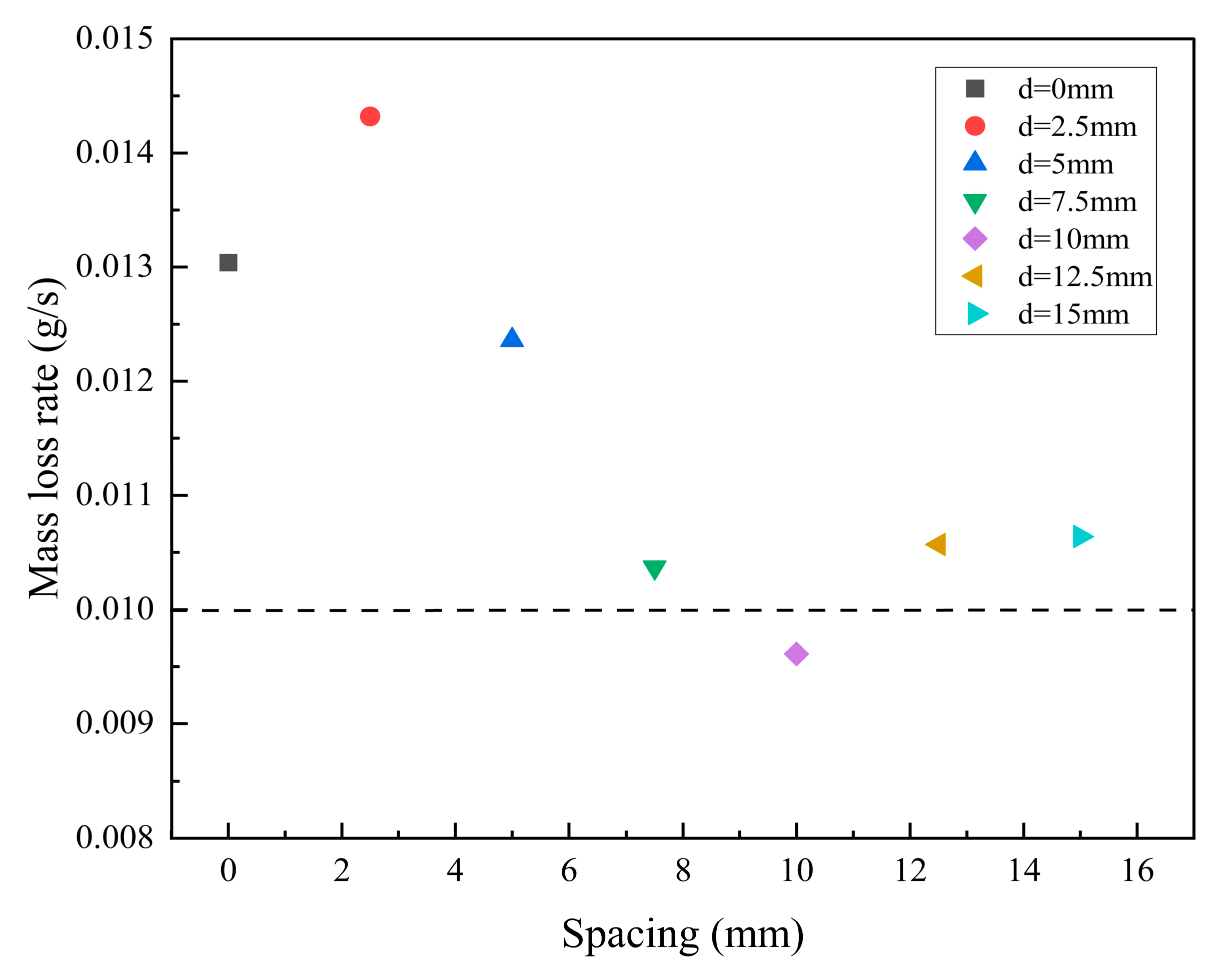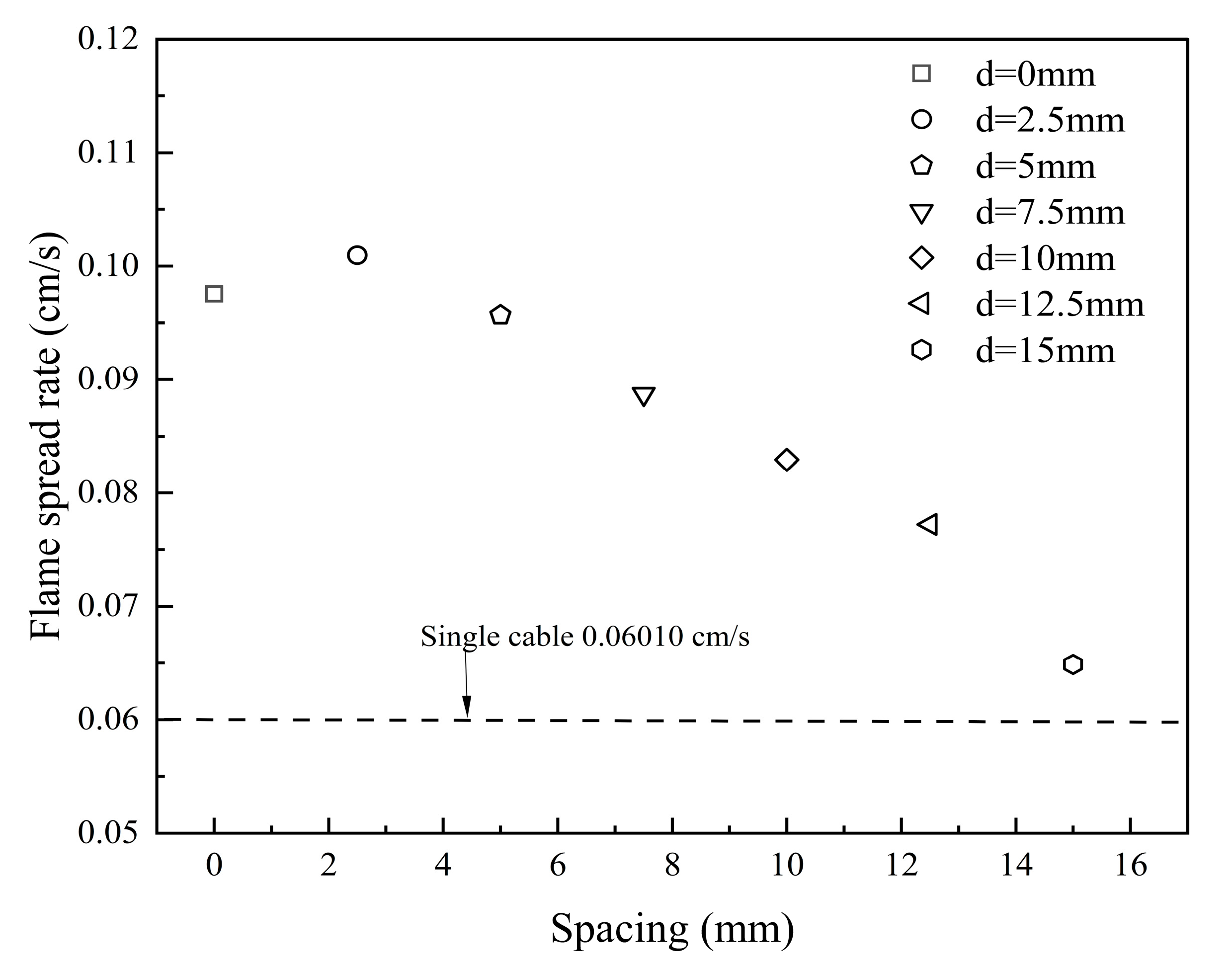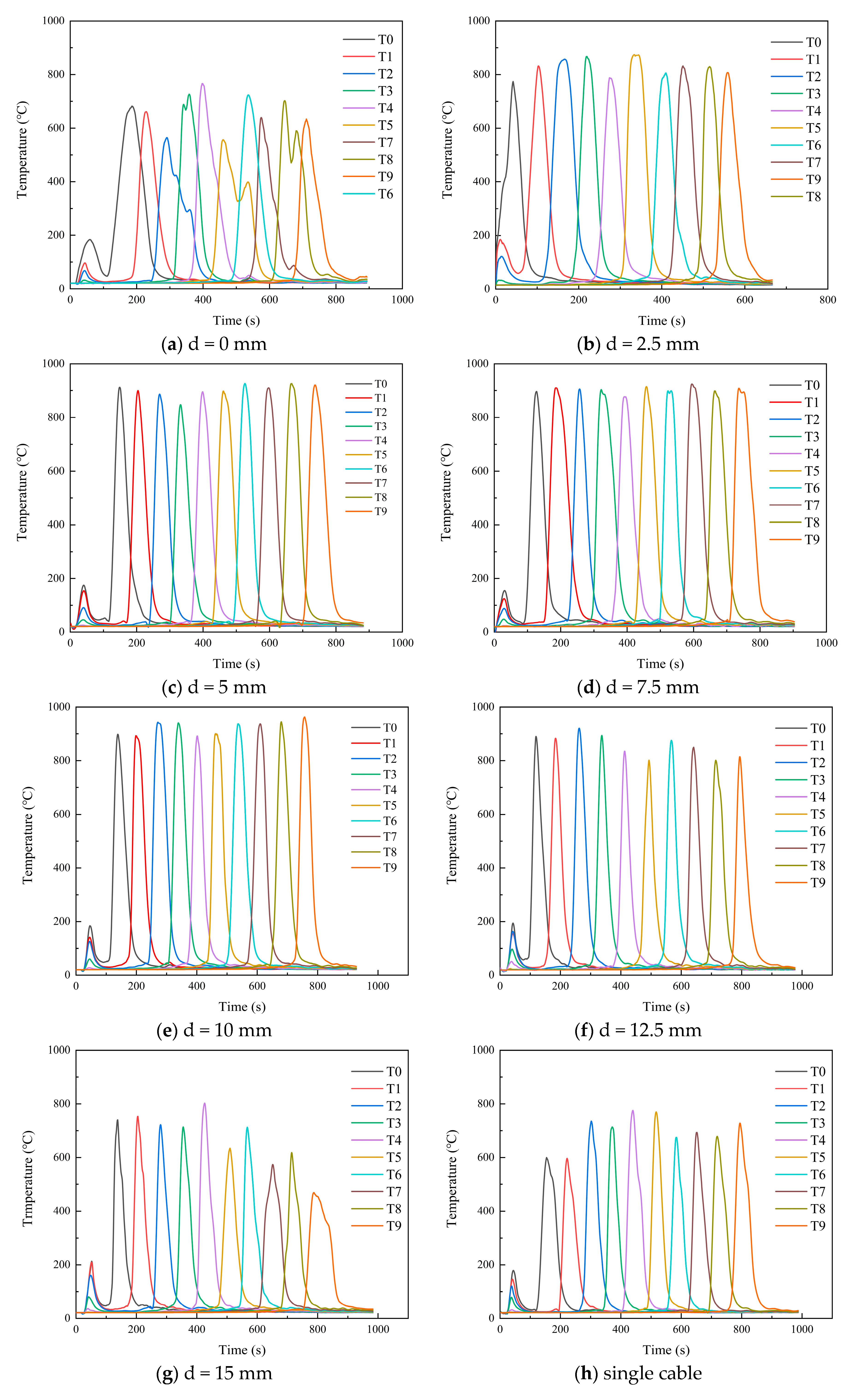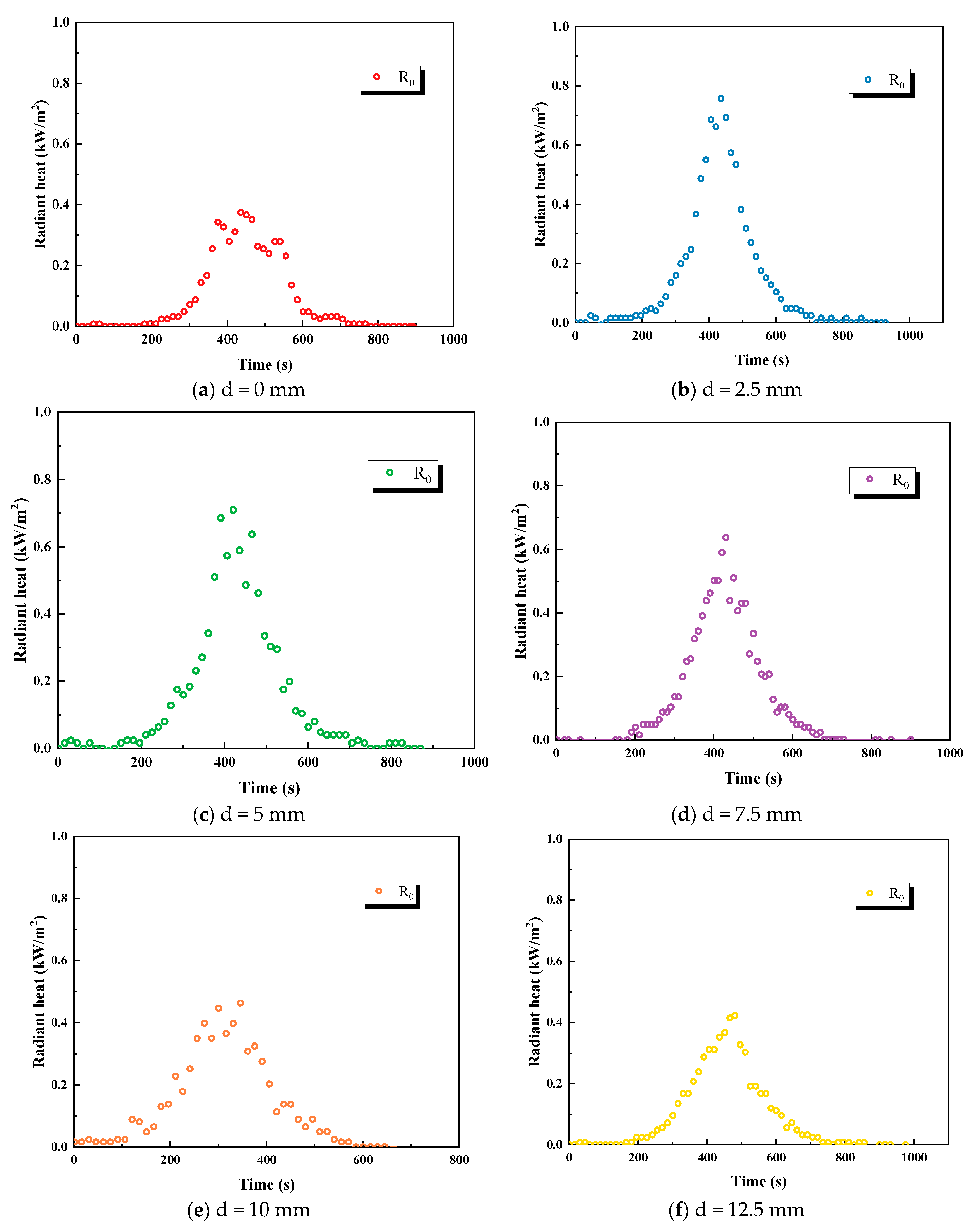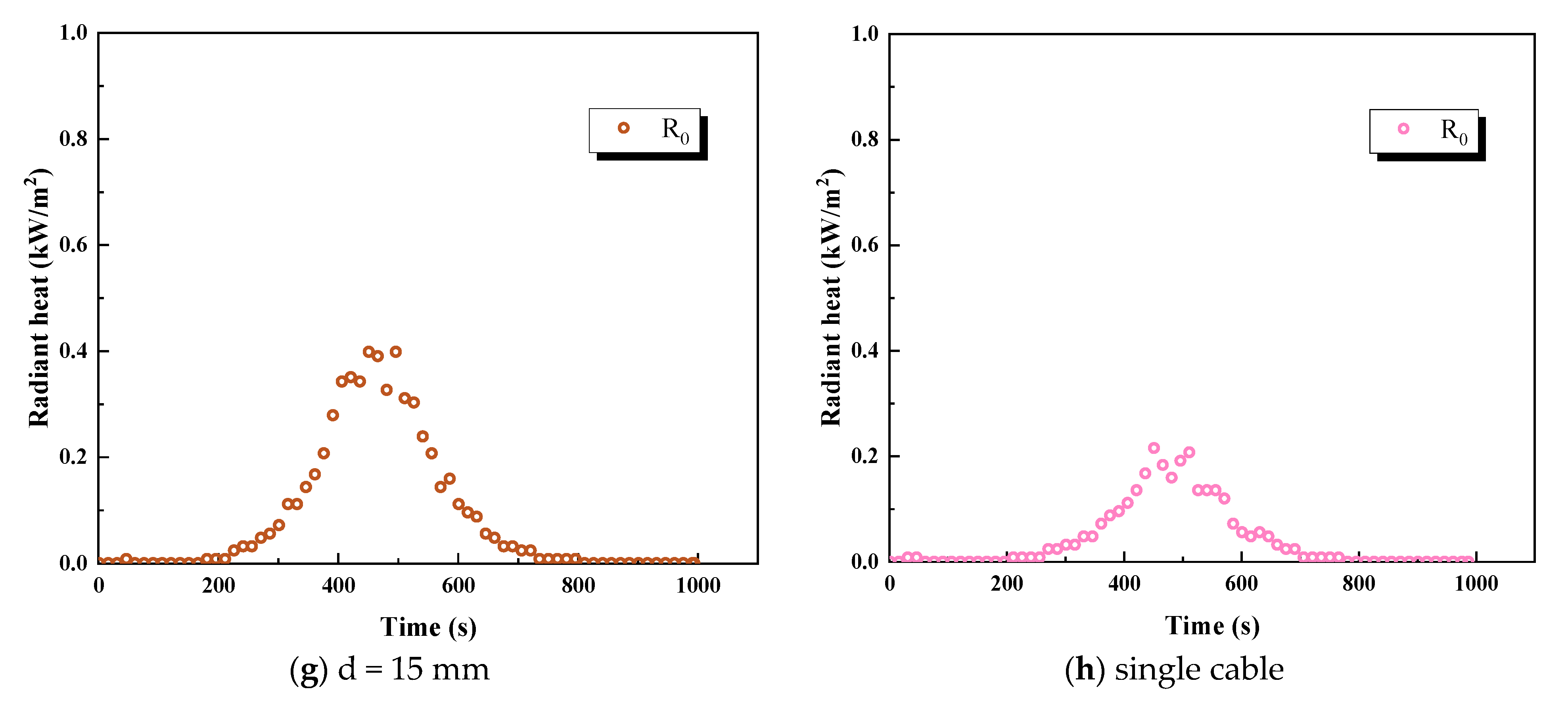1. Introduction
In recent years, with the rapid advancement of economic development and urbanization, the coverage area of cable installations has expanded dramatically, thereby supporting the modernization of the Chinese power system and other critical infrastructures [
1]. Cables, as essential components of power transmission and distribution networks, play vital roles in ensuring the continuous operation of industrial, commercial, and residential systems. Structurally, cables are composed of a conductive core, typically made of copper or aluminum, and an insulation sheath, which protects the core and prevents short circuits. Based on the properties of the insulation materials, cables are broadly classified into thermoplastic and thermoset types [
2].
In fire scenarios, thermoplastic cables pose significant safety hazards. Upon heating, the thermoplastic insulation material softens, melts, and accumulates. Once a critical temperature is reached, the accumulated molten material may drip, exacerbating fire propagation by igniting other flammable objects and expanding the fire area [
3,
4,
5]. This dripping phenomenon increases both the fire spread rate and the difficulty of fire suppression. Therefore, understanding the combustion characteristics of thermoplastic cables is crucial for improving fire risk assessments, enhancing fire prevention strategies, and informing safer engineering designs.
To date, a considerable number of studies have explored the combustion and flame propagation behaviors of cables under various conditions. Researchers have examined the influence of factors such as cable orientation [
6], external wind speed [
7], insulation material properties [
8], cable laying configurations [
9,
10], and surrounding pressure environments [
11,
12,
13] on fire spread dynamics. For example, Mun et al. [
14] simulated the pyrolysis processes of flame-retardant cables using the Fire Dynamics Simulator (FDS), demonstrating that different cable structures and compositions lead to significantly varied pyrolysis rates and flame behaviors. Similarly, Zavaleta et al. [
15] conducted experiments on horizontally preheated cable layers and emphasized that flame spread rate and fire growth are strongly temperature-dependent. An et al. [
16] revealed that under different spacing and confinement conditions, moderate spacing combined with side or vertical confinement strengthens air entrainment in the gap, promoting effective heat transfer and stable flame merging, thereby accelerating flame spread. Huang et al. [
17] studied that as spacing and confinement change, air entrainment patterns adjust the flame shape, merging extent, and heat transfer, with optimal entrainment at moderate gaps enhancing flame height, width, and spread rate.
The influence of external environmental factors was further explored by Jia et al. [
18], who found that in the presence of horizontal winds, flame spread along inclined wires accelerated significantly, reaching maximum rates when the flame was pushed parallel to the cable axis. Gong [
19,
20] extensively studied the ignition phenomena, spontaneous ignition mechanisms, and flame spread patterns of cables, proposing a fire hazard evaluation method based on surface temperature and critical mass flux. These studies collectively advanced the understanding of single-cable fire behaviors and associated risks.
However, it is important to note that most previous research has focused on the combustion behavior of single cables [
21], whereas in practical engineering scenarios, cables are often laid in bundles or in parallel arrays. In such multi-cable configurations, flame interactions between adjacent cables can significantly alter fire dynamics compared to isolated single-cable fires [
22]. Hu et al. [
23] investigated flame spread over polyethylene-insulated copper wires at different inclinations, highlighting a distinct U-shaped dependence of flame spread rate on inclination angle and developing predictive models incorporating flame geometry and heat conduction effects. Carcillo et al. [
24] further analyzed the influence of cable structure and layout on fire behavior using cone calorimeter tests, revealing that cable sheath thickness and spatial arrangement significantly impact heat release rates and ignition characteristics. Lu et al. [
25] experimentally revealed the interaction of flame spread between two parallel electrical wires at varying separations, showing that flame merging occurs at moderate distances (approximately 8–10 times the wire diameter). The research clarified that flame merging enhances convective and radiative heat feedback, significantly promoting flame spread behavior. Huang et al. [
26,
27] demonstrated that both wire spacing and side or vertical confinement significantly influence flame merging behavior between two parallel electrical wires. Optimal geometric configurations—characterized by moderate spacing and confined boundaries—promote continuous flame merging, enhance convective and radiative heat feedback, and substantially accelerate flame spread.
Despite these valuable contributions, the specific influence of cable spacing—a key geometric factor in multi-cable installations—on combustion behavior remains insufficiently addressed. In practical settings such as utility tunnels, industrial plants, and communication hubs, inappropriate cable spacing could unintentionally create conditions that promote faster fire spread due to enhanced flame interaction and radiative heat feedback. To address this gap, this present study systematically investigates the effect of cable spacing on the combustion characteristics of two parallel-laid thermoplastic cables. By analyzing flame merging behavior, flame morphology, flame spread rate, mass loss, temperature profiles, and radiative heat flux under varying spacing conditions, this work aims to reveal the underlying physical mechanisms governing multi-cable fire dynamics and to provide practical insights for safer cable installation designs.
2. Experimental Setup and Methodology
To investigate the influence of cable spacing on the combustion behavior of thermoplastic-sheathed cables, a custom-designed experimental apparatus was constructed, as illustrated in
Figure 1. The system comprises a cable burning bracket, electronic balance, array of K-type thermocouples, radiative heat flux meter, and high-definition video cameras. This setup enables precise observation and measurement of critical combustion parameters under controlled spacing conditions.
2.1. Test Samples and Configuration
The test cables were made of polyethylene (PE) insulation and a copper core, with the detailed physical parameters listed in
Table 1. Each cable had an outer diameter of 5 mm, a core diameter of 3 mm, and an insulation layer thickness of 1 mm. All test cables were cut to a uniform length of 0.8 m.
To evaluate the effect of spacing (the distance between the outer surfaces of the cable insulation) between two parallel cables, seven spacing intervals were selected: 0 mm, 2.5 mm, 5 mm, 7.5 mm, 10 mm, 12.5 mm, and 15 mm. A single-cable test served as a baseline control. The ends of the cables were secured in pre-defined grooves on the burning rack using adjustable turnbuckles, allowing fine control of the spacing during setup.
2.2. Measurement Instruments and Layout
The entire cable holder was mounted above an electronic balance (capacity: 12.0 kg; precision: 0.01 g), which continuously recorded mass loss during combustion. Thermal insulation was applied between the balance and the setup to prevent heat interference. Data were collected via a USB-to-RS485 converter and logged in real time on a connected computer.
A total of 10 K-type thermocouples (T0–T9), each with a 1 mm diameter, were installed horizontally above the cable surface at 5 cm intervals, aligned with the flame spread direction. The thermocouple tips were positioned 1 cm above the central axis of the cable flame. The radiative heat flux meter R0 is installed between thermocouples T4 and T5 and is positioned at the same horizontal level as them.
Two SONY FDR-AX700 cameras (SONY, Tokyo, Japan) were used for visual analysis. One was placed laterally to capture the flame shape and merging phenomena, while the other recorded the flame propagation process from the front. Captured images were used for flame height measurement and flame spread rate calculation through digital image processing.
2.3. Ignition and Procedure
An external ignition source, comprising a portable butane gas canister and a compatible blowtorch, was used to ignite the cable. The blowtorch produced a flame with an approximate temperature of 1300 °C. Each ignition was maintained for 20 s or until sustained flame propagation was visually confirmed, after which the flame source was withdrawn.
All experimental conditions, including each cable spacing configuration and the single-cable control, were repeated three times to ensure reproducibility. After each test, thermocouple tips were cleaned to remove soot and ensure measurement accuracy.
3. Experimental Results
3.1. Flame Morphology and Merging Behavior
The flame morphology under different cable spacing conditions was extracted from the recorded side-view videos. A 20 s segment representing the quasi-steady burning stage was selected and combined with a 10 s black background to facilitate image segmentation. Using a MATLAB MCR2013a v8.1-based image processing program, the flame images were converted into grayscale and binary formats, scaled based on reference markers, and then imported into Tecplot for shape reconstruction and data visualization.
Figure 2 shows the stable flame shapes for two parallel cables at spacings of 0, 2.5, 5, 7.5, 10, 12.5, and 15 mm, alongside a single-cable control.
Table 2 shows the flame height at a steady state under different cable spacings. The results reveal clear spacing-dependent transitions in flame behavior, which can be categorized into three distinct modes based on merging characteristics, following the classification proposed by Li [
28]: (i) continuous merging, complete flame fusion along the entire height (e.g., d = 0 mm); (ii) intermittent merging, partial merging observed in middle and upper flame regions (e.g., d = 2.5 mm, 5 mm); (iii) non-merging, two fully separated flames with altered morphology (d ≥ 10 mm).
At 0 mm, the cables are in full contact, and the generated flames fully merge into a single vertical flame column. However, the close spacing limits oxygen access to the inner interface, leading to incomplete combustion, heavy smoke, and increased molten droplet formation. The lack of air entrainment within the contact zone suppresses flame symmetry, resulting in a short and broadened flame profile.
At 2.5 mm, identified as the critical spacing, the flame base begins to diverge while the upper sections remain merged. This spacing permits partial inner-side air entrainment, forming a narrow triangular zone of induced upward airflow between the flames, as schematized in
Figure 3. This upward-induced flow stretches the flame vertically and enhances the combustion intensity. The flame inclination towards the center is most pronounced here due to asymmetric pressure distribution between the inner and outer sides.
As the spacing further increases to 5 mm, flame merging persists primarily at the tip, while the base separation expands. The flame remains inclined inward due to residual thermal coupling and lateral entrainment, but the effective flame height begins to decrease due to reduced induced flow velocity and increased convective cooling.
When the spacing exceeds 7.5 mm, the flames no longer physically interact. At 10 mm, 12.5 mm, and 15 mm, the flame shapes exhibit fully independent profiles, though they remain tilted inward due to residual thermal radiation from the neighboring flame. Importantly, even in this non-merging stage, the flame heights remain higher than the single-cable flame, confirming the presence of mutual radiative feedback. The continued proximity of the two heat sources enhances the pyrolysis rate of the adjacent insulation material, promoting vertical flame growth. In comparison, the single cable forms a nearly symmetrical, vertically rising flame. The pyrolysis gases rise freely under buoyant forces, entraining ambient air uniformly from all directions. This results in a stable flame with minimal distortion or tilting.
Figure 3 further illustrates the contrasting air entrainment mechanisms [
29,
30]. In the dual-cable case, the limited air entrainment on the inner side and stronger entrainment on the outer side couple the two flames together, forming a triangular recirculation zone. The upward-induced airflow within this recirculation zone stretches the flame vertically, thereby increasing the flame height. However, as spacing increases, the effective entrainment area grows, but the thermal interaction weakens, leading to a decrease in both flame inclination and height [
31].
In summary, the flame shape transitions are highly sensitive to cable spacing. The 2.5 mm spacing produces the tallest, most coupled flame due to the balance between induced airflow and radiative interaction. Beyond this point, the dominance of cooling over coupling reduces flame height and alters the flame profile. These findings demonstrate that cable spacing is a critical parameter in controlling flame morphology, which has significant implications for fire spread dynamics and hazard evaluation in cable installations.
3.2. Mass Loss Characteristics
Mass loss is a direct indicator of the fire scale during cable combustion and serves as a key parameter for assessing fire hazards. During a cable fire, the polymer insulation material undergoes pyrolysis and subsequent combustion, resulting in a continuous reduction of cable mass.
Figure 4 presents the mass variation over time at a cable spacing of d = 7.5 mm. The entire combustion process can be divided into three distinct stages.
- (i)
Preheating stage: Characterized by a slight mass loss due to initial heating and onset of pyrolysis, without sustained flame spread.
- (ii)
Quasi-steady burning stage: A period of relatively stable flame propagation and continuous, nearly linear mass loss, indicating stable combustion dynamics.
- (iii)
Decay stage: Marked by a sharp decline in flame intensity and a significant reduction in mass loss rate as the available combustible material diminishes.
In this study, both the flame spread rate and mass loss rate were evaluated during the quasi-steady burning stage, where burning behavior remains consistent and representative of typical fire spread conditions.
Figure 5 illustrates the variation of the mass loss rate with different cable spacings. The dashed line represents the theoretical superposition of two individually burning single-cable mass loss rates. It can be observed that as cable spacing increases, the mass loss rate of the double-cable configuration first increases, reaches a maximum, and then decreases, eventually approaching the dashed line at larger spacings. The maximum mass loss rate occurs at a spacing of d = 2.5 mm, coinciding with the critical spacing identified in flame morphology analysis.
This phenomenon can be attributed to the upward-induced airflow formed between the two cables at small spacings. The confined gap promotes the stronger vertical entrainment of air, enhancing oxygen supply, accelerating the pyrolysis process, and resulting in a higher burning rate. The extended flame height observed at this spacing also contributes to the intensified combustion. As the cable spacing increases beyond 2.5 mm, the flame height gradually decreases due to weakened coupling effects and enhanced convective cooling. Consequently, air entrainment efficiency reduces, the pyrolysis rate declines, and the mass loss rate steadily approaches that of two independent single-cable fires. These results confirm that cable spacing plays a decisive role in modulating the combustion intensity and that improper spacing could exacerbate fire hazards by promoting more vigorous burning in closely packed cable arrangements.
3.3. Flame Spread Rate Analysis
Flame spread rate is a critical parameter for characterizing the propagation behavior and hazard potential of cable fires [
32]. In this study, flame spread velocity was determined by processing the experimental video frames using a custom-developed MATLAB image analysis program. The progression of the flame front was tracked over time, and the spread rate was calculated based on the time-stamped movement of the visible flame front along the cable axis.
Figure 6 illustrates the variation in flame spread rate under different cable spacing conditions. A general trend is observed: as the spacing between the two cables increases, the flame spread rate initially increases, reaches a peak at 2.5 mm, and then gradually decreases, eventually approaching the spread rate of a single cable (0.0601 cm/s, indicated by the dashed line).
The maximum flame spread rate is observed at a spacing of d = 2.5 mm, where it reaches approximately 1.7 times that of a single cable. This sharp increase is attributed to a combination of enhanced air entrainment, radiative heat feedback, and flame interaction effects. At this spacing, the flame bases are sufficiently separated to allow for upward-induced airflow in the gap between the cables, significantly improving combustion conditions. Additionally, the close proximity of the two flames facilitates thermal interaction and feedback radiation, further accelerating flame propagation.
Interestingly, at d = 0 mm, although the cables are tightly in contact and oxygen access is severely restricted on the inner side, the flame spread rate remains relatively high—second only to that at 2.5 mm. This is due to the increased contact area between the flame and the insulation layer, as well as intensive molten dripping in the early combustion stage. The close packing enhances surface heat transfer, contributing to a moderate spread rate during the quasi-steady burning stage despite the limited air supply.
As the spacing continues to increase beyond 2.5 mm, the flame interaction weakens and the radiative heat transfer between adjacent flames diminishes. At larger spacings (10 mm and above), the flame spread rate shows a marked decline and converges toward the single-cable baseline. This is due to the reduced synergistic effects, where each cable burns more independently, and the mutual influence becomes negligible.
These findings confirm that cable spacing critically governs flame propagation dynamics, with the 2.5 mm spacing representing a critical threshold for flame synergy. Ignoring such effects in cable layout design could lead to the underestimation of fire spread risk, particularly in compact or densely wired systems.
3.4. Temperature Evolution During Combustion
Flame temperature is one of the most intuitive indicators of combustion intensity and heat transfer during flame propagation. It directly reflects the thermal feedback environment that governs the pyrolysis rate, flame spread, and radiative heat flux. In this study, temperature profiles were recorded using ten horizontally aligned K-type thermocouples (T0–T9), placed at 5 cm intervals above the flame path.
Figure 7 illustrates the temporal temperature variations under eight different cable configurations: seven dual-cable spacings (0–15 mm) and a single-cable control group. Each subfigure (a–h) corresponds to a different spacing condition. At the initial stage of each curve, minor temperature fluctuations are observed across all thermocouples. These are attributed to transient exposure to igniter radiation prior to stable flame formation. Once sustained combustion is achieved, the temperature rises sharply at each thermocouple as the flame front propagates. A notable observation is that the peak flame temperatures vary significantly with cable spacing: (i) at d = 2.5 mm to 12.5 mm, the peak temperatures exceed 900 °C, indicating vigorous combustion and strong flame interaction; (ii) in contrast, at d = 0 mm and d = 15 mm, the peak temperatures are lower, ranging from 600 °C to 800 °C, similar to the values observed for the single cable.
The reduction in flame temperature at d = 0 mm is attributed to the insufficient oxygen supply along the inner surfaces of the closely spaced cables. The tight contact limits air entrainment and leads to incomplete combustion, particularly on the inner side. This condition results in a greater production of molten droplets, which suppresses flame intensity and reduces available combustible mass [
33]. Although the flame spreads forward and preheats downstream regions, the overall combustion efficiency is compromised, reflected in a broader but cooler flame profile.
At the opposite extreme, d = 15 mm, the cables are sufficiently separated such that inter-cable interaction becomes negligible. In this case, radiative feedback between flames is minimal, and the combustion behavior resembles that of two independent single cables. As a result, the flame temperature closely aligns with the single-cable baseline, exhibiting limited enhancement from adjacent heat sources [
34]. In contrast, the spacing range d = 2.5 mm to 12.5 mm represents a thermal coupling zone, where increased air entrainment and radiative reinforcement between the flames promote higher combustion efficiency. Among these, d = 2.5 mm corresponds to the critical spacing that simultaneously optimizes air supply and flame interaction, contributing to both the highest flame spread rate and peak temperature.
These results highlight the sensitivity of flame temperature to cable layout, reaffirming that spacing plays a pivotal role in regulating the thermal environment of cable fires. In particular, improper spacing can either suppress combustion through oxygen deficiency or diminish synergistic effects due to over-separation, both of which influence the fire growth rate and heat release characteristics.
3.5. Radiative Heat Flux Variation
To evaluate the influence of cable spacing on the radiative heat transfer characteristics during combustion, a radiative heat flux meter (R0) was installed horizontally between thermocouples T4 and T5, aligned with the central axis of flame propagation. This setup enabled real-time recording of the radiant heat flux throughout the burning process under various spacing configurations.
Figure 8 presents the time-resolved radiant heat flux curves for seven dual-cable spacing conditions and a single-cable control. Prior to the flame front reaching the sensor, the heat flux readings remained near zero, indicating negligible thermal radiation. As the flame approached during the preheating stage, the readings began to rise gradually. Upon entering the quasi-steady burning stage, the combined effects of flame radiation and convective heat transfer led to a rapid increase in radiant heat, peaking when the flame front passed directly above the sensor. In the decay stage, the heat flux steadily declined as the flame moved beyond the measurement point and combustion subsided.
A detailed comparison of the radiant heat flux profiles in
Figure 8 reveals a distinct non-monotonic pattern: as the cable spacing increases from 0 mm to 2.5 mm, the peak radiant heat flux correspondingly rises, reaching its maximum at 2.5 mm. Beyond this critical spacing, a gradual decline in peak values is observed with further spacing increments, ultimately converging toward the baseline level measured for the single-cable configuration at 15 mm.
This trend aligns closely with those observed in mass loss rate and flame spread rate, reinforcing the coupling among thermal feedback, pyrolysis efficiency, and combustion dynamics. At d = 0 mm, the tight contact between cables restricts oxygen access to the inner insulation surfaces, leading to incomplete combustion and lower flame intensity. Additionally, excess molten dripping reduces available combustible content, resulting in weakened radiative output. At d = 2.5 mm, optimal air entrainment into the inter-cable gap enhances oxygen supply and combustion completeness. Simultaneously, flame interaction and mutual radiative reinforcement are maximized, producing the highest recorded heat flux and signaling the presence of a critical spacing for radiative synergy. As the spacing increases beyond this point, the flames become more isolated, the thermal interaction weakens, and radiative feedback diminishes. By d = 15 mm, the system behaves similarly to two independent single-cable fires, with the radiant heat flux closely resembling that of the control case.
In summary, cable spacing significantly influences radiative energy release, which in turn governs heat feedback, flame propagation, and the intensity of the fire hazard. Identifying and avoiding critical spacing conditions such as 2.5 mm, where energy release is maximized, is essential for mitigating fire spread risks in densely wired environments.
4. Discussion
This present study confirms that cable spacing exerts a decisive influence on the combustion behavior of parallel thermoplastic cables, with the experimental results revealing clear non-monotonic trends across all key parameters. A critical spacing of 2.5 mm was identified, where the flame spread rate, mass loss rate, and radiant heat flux all reached their respective peaks. This enhanced burning behavior is attributed to a synergistic effect: sufficient spacing allows for effective air entrainment, while the close proximity of the two flames enables strong radiative feedback and thermal coupling. These combined factors accelerate insulation pyrolysis and promote intense flame propagation, underscoring the hazardous nature of cable configurations at or near this spacing.
At smaller spacings, particularly d = 0 mm, the close contact between cables inhibits oxygen penetration into the inner surfaces, resulting in incomplete combustion and extensive molten droplet formation, which suppresses flame temperature and reduces radiative output. Although the specific surface area and contact with the flame are relatively large, the oxygen-deficient environment limits combustion efficiency, and the associated dripping behavior introduces additional ignition risks. Conversely, at larger spacings (≥10 mm), the flames become fully separated, and the reduction in radiative interaction leads to decreased flame intensity, lower heat release, and combustion behavior that closely resembles that of independent single cables.
These findings have important engineering implications, especially for high-density cable installations in confined environments such as tunnels, utility corridors, or data centers. Improper cable spacing may unintentionally induce flame synergy, leading to unexpectedly rapid fire spread and heightened thermal hazards. Therefore, cable spacing should be treated as a critical design parameter in fire safety assessments. Moreover, the results suggest avenues for improving computational fire models, particularly by incorporating flame merging dynamics, airflow induction, and spacing-dependent feedback mechanisms. This will enable more accurate predictions of fire growth and spread in multi-cable systems, thereby enhancing the reliability of fire risk evaluations and contributing to the formulation of safer design standards.
This study also has some limitations in experimental design and data processing. The pyrolysis region’s spatial distribution and length were not quantitatively analyzed, limiting insights into the link between flame spread and thermal feedback. Although multiple thermocouples were used, the temperature data were not corrected for radiation loss, which may have affected the accuracy of flame intensity evaluation. Additionally, thermocouple data were not used to estimate flame spread rate, hindering detailed analysis of propagation dynamics. Future work will address these issues by optimizing thermocouple placement, applying radiative corrections, and using multi-source data to improve measurement accuracy and spatiotemporal resolution.
Furthermore, this study suggests important directions for refining computational fire models. Current tools like FDS may underrepresent flame merging dynamics and spacing-sensitive thermal feedback. Integrating these factors could improve model fidelity, particularly for multi-source fire growth scenarios. Future research should investigate the role of ventilation, cable orientation, and bundle configurations under varying fire loads to further generalize the applicability of these findings.
5. Conclusions
In this study, a series of controlled fire experiments were conducted to investigate the influence of cable spacing on the combustion characteristics of two parallel thermoplastic-sheathed cables. Key parameters such as flame morphology, mass loss rate, flame spread rate, temperature distribution, and radiant heat flux were systematically measured and analyzed under seven spacing conditions, with a single-cable test as a reference.
The results revealed a critical spacing of 2.5 mm, at which the combustion behavior was most intense. At this spacing, synergistic effects led to the maximum flame spread rate (approximately 1.7 times that of a single cable), peak mass loss, highest flame temperature, and strongest radiant heat release. In contrast, very small spacing (e.g., 0 mm) restricted airflow and caused incomplete combustion and droplet formation, while larger spacings (≥10 mm) diminished inter-flame interactions, leading to combustion behavior similar to that of isolated cables.
These findings highlight the significant role of cable spacing in fire hazard development. Therefore, it is recommended that fire safety regulations and cable installation guidelines explicitly consider minimum spacing requirements, particularly in high-density cable trays or confined spaces, to mitigate the risk of rapid flame spread and reduce potential fire losses. Additionally, incorporating optimal cable layout strategies in the early design phase can enhance the overall resilience of electrical systems in critical infrastructure. This study provides not only fundamental insights into the flame interaction mechanisms of multi-cable systems but also practical guidance for safe cable layout design in industrial, civil, and infrastructure applications. Future work may extend these findings by exploring additional factors such as insulation material types, vertical versus inclined configurations, and external ventilation effects, and by incorporating the present experimental data into numerical fire models for predictive risk assessment in complex cable systems.
Author Contributions
Conceptualization, J.W.; Methodology, R.Q.; Software, Y.L.; Validation, X.Z.; Formal analysis, X.Z.; Data curation, X.Z. and J.W.; Writing—original draft, X.Z. and R.Q.; Writing—review & editing, C.D. and Y.J.; Visualization, Y.L.; Supervision, Y.J.; Project administration, R.Q. and C.D.; Funding acquisition, C.D. and R.Q. All authors have read and agreed to the published version of the manuscript.
Funding
This work is supported by National Natural Science Foundation of China (No. 52476097), the Provincial Natural Science Research Project of Universities in Anhui Province—Outstanding Youth (No. 2022AH030037), the Key Project of Support Plan for Outstanding Young Talents in Universities in Anhui Province (No. gxyqZD2022058), the Doctoral Research Initiation Fund of Anhui Jianzhu University (No. 2021QDZ04), and the Anhui Provincial Department of Education key project (No. 2024AH050252). The authors gratefully acknowledge this support.
Institutional Review Board Statement
Not applicable.
Informed Consent Statement
Not applicable.
Data Availability Statement
The data presented in this study are available on request from the corresponding author.
Conflicts of Interest
The authors declare no conflicts of interest.
References
- Meng, X.; Yu, H.; Lu, Z.; Jin, T. Catalytic Pyrolysis of Polypropylene for Cable Semiconductive Buffer Layers. Polymers 2024, 16, 1435. [Google Scholar] [CrossRef] [PubMed]
- Pourrahimi, A.M.; Mauri, M.; D’Auria, S.; Pinalli, R.; Müller, C. Alternative Concepts for Extruded Power Cable Insulation: From Thermosets to Thermoplastics. Adv. Mater. 2024, 36, 2313508. [Google Scholar] [CrossRef] [PubMed]
- Fernandez–Pello, A.C.; Hasegawa, H.K.; Staggs, K.; Lipska-Quinn, A.E.; Alvares, N.J. A study of the fire performance of electrical cables. In Fire Safety Science; Routledge: Oxford, UK, 1991; pp. 237–247. [Google Scholar]
- Tang, K.; Wang, S.; Fu, M.; Tian, F.; Chen, X.; Zhang, Y. Comprehensive assessment of the thermal aging effects on fire risks of PVC cable. J. Therm. Anal. Calorim. 2024, 149, 3785–3793. [Google Scholar] [CrossRef]
- Courty, L.; Garo, J.P. External heating of electrical cables and auto-ignition investigation. J. Hazard. Mater. 2017, 321, 528–536. [Google Scholar] [CrossRef]
- Xu, T.; Chen, C.; Du, W.; Gao, F.; Wang, Z.; Yi, T. Experimental study on fire spread behavior of single 110 kV cable under different layout conditions. Fire Saf. J. 2023, 141, 103957. [Google Scholar] [CrossRef]
- Wang, T.; Tang, Y.; Wang, Z.; An, W.; Chen, X. Flame spread over cables in a utility tunnel: Effect of longitudinal wind and inclination angle. Tunn. Undergr. Space Technol. 2023, 131, 104848. [Google Scholar] [CrossRef]
- Gao, K.; Liu, Z.; Jia, J.; Liu, Z.; Aiyiti, Y.; Qi, Z.; Wu, Y.; Li, S. Study on flame spread characteristics of flame-retardant cables in mine. Adv. Polym. Technol. 2020, 2020, 8765679. [Google Scholar]
- Huang, X.; Wang, Y.; Ren, Z.; Li, Z.; Cheng, C.; Chow, W. Experimental investigation on maximum ceiling jet temperature generated by a vertically spreading cable fire. Fire Saf. J. 2021, 120, 103125. [Google Scholar] [CrossRef]
- Chen, C.; Du, W.; Xu, T. Experimental Study on Combustion Behavior of U-Shaped Cables with Different Bending Forms and Angles. Fire 2023, 6, 348. [Google Scholar] [CrossRef]
- Xu, D.; Li, Y.; Li, J.; Zhong, H.; Li, J.; Tu, D.; Huang, Y. Evaluating the combustion and flame extension characteristics of cable fire in utility tunnels with spontaneous combustion scenarios: An experimental study. Tunn. Undergr. Space Technol. 2023, 140, 105244. [Google Scholar] [CrossRef]
- Zheng, X.; Cai, G.; Guo, J.; Gao, W.; Huang, Y.; Tong, X. Combustion characteristics and thermal decomposition mechanism of the flame-retardant cable in urban utility tunnel. Case Stud. Therm. Eng. 2023, 44, 102887. [Google Scholar] [CrossRef]
- Citerne, J.M.; Dutilleul, H.; Kizawa, K.; Nagachi, M.; Fujita, O.; Kikuchi, M.; Jomaas, G.; Rouvreau, S.; Torero, J.L.; Legros, G. Fire safety in space–investigating flame spread interaction over wires. Acta Astronaut. 2016, 126, 500–509. [Google Scholar] [CrossRef]
- Mun, S.Y.; Hwang, C.H. Experimental and numerical studies on major pyrolysis properties of flame retardant PVC cables composed of multiple materials. Materials 2020, 13, 1712. [Google Scholar] [CrossRef] [PubMed]
- Zavaleta, P.; Meinier, R.; Suard, S.; Sonnier, R.; Ferry, L. Flame Spread Experiments on a Horizontal Preheated Cable Layer. Fire Technol. 2024, 60, 641–667. [Google Scholar] [CrossRef]
- An, W.; Tang, Y.; Liang, K.; Wang, T.; Zhou, Y.; Wen, Z. Experimental study on flammability and flame spread characteristics of polyvinyl chloride (PVC) cable. Polymers 2020, 12, 2789. [Google Scholar] [CrossRef]
- Huang, X.; Zhu, H.; Peng, L.; Zheng, Z.; Zeng, W.; Bi, K.; Cheng, C.; Chow, W. Thermal characteristics of vertically spreading cable fires in confined compartments. Fire Technol. 2019, 55, 1849–1875. [Google Scholar] [CrossRef]
- Jia, S.; Hu, L.; Ma, Y.; Zhang, X.; Fujita, O. Experimental study of downward flame spread and extinction over inclined electrical wire under horizontal wind. Combust. Flame 2022, 237, 111820. [Google Scholar] [CrossRef]
- Gong, T.; Xie, Q.; Huang, X. Fire behaviors of flame-retardant cables part I: Decomposition, swelling and spontaneous ignition. Fire Saf. J. 2018, 95, 113–121. [Google Scholar] [CrossRef]
- Xie, Q.; Gong, T.; Huang, X. Fire zone diagram of flame-retardant cables: Ignition and upward flame spread. Fire Technol. 2021, 57, 2643–2659. [Google Scholar] [CrossRef]
- Huang, X.; Ren, Z.; Zhu, H.; Peng, L.; Cheng, C.; Chow, W. A modified zone model on vertical cable tray fire in a confined compartment in the nuclear power plant. J. Fire Sci. 2018, 36, 472–493. [Google Scholar] [CrossRef]
- Liu, N.; Liu, Q.; Deng, Z.; Satoh, K.; Jiping, Z. Burn-out time data analysis on interaction effects among multiple fires in fire arrays. Proc. Combust. Inst. 2007, 31, 2589–2597. [Google Scholar] [CrossRef]
- Hu, L.; Zhang, Y.; Yoshioka, K.; Izumo, H.; Fujita, O. Flame spread over electric wire with high thermal conductivity metal core at different inclinations. Proc. Combust. Inst. 2015, 35, 2607–2614. [Google Scholar] [CrossRef]
- Magalie, C.; Anne-Sophie, C.; Rodolphe, S.; Laurent, F.; Emmanuelle, G.; Christian, L. Fire behaviour of electrical cables in cone calorimeter: Influence of cables structure and layout. Fire Saf. J. 2018, 99, 12–21. [Google Scholar] [CrossRef]
- Lu, Y.; Hu, L.; Ma, Y.; Guo, Z.; Wang, Q. An experimental investigation of flames spread interaction over two parallel electrical wires of various separations. Proc. Combust. Inst. 2023, 39, 3813–3821. [Google Scholar] [CrossRef]
- Huang, X.; Ding, H.; Yin, Z.; Zhao, Y.; Wang, M.; Wang, C. Effects of side-confined distance and wire spacing on the flame spread and merging characteristics over two energy wires. Energy 2025, 322, 135584. [Google Scholar] [CrossRef]
- Huang, X.; Zhang, M.; Ding, H.; Xu, P.; Zhang, X.; Li, X.; Wang, M.; Zhang, P. Effects of confined distance and wire spacing on flame spread over double electrical wires for the layout design in buildings. J. Build. Eng. 2024, 92, 109765. [Google Scholar] [CrossRef]
- Li, B.; Wan, H.; Gao, Z.; Ji, J. Experimental study on the characteristics of flame merging and tilt angle from twin propane burners under cross wind. Energy 2019, 174, 1200–1209. [Google Scholar] [CrossRef]
- Hu, L.; Huang, L.; Wang, Q.; Kuwana, K. Experimental study and analysis on the interaction between two slot-burner buoyant turbulent diffusion flames at various burner pitches. Combust. Flame 2017, 186, 105–113. [Google Scholar] [CrossRef]
- Zhao, S.; Du, K.; Yao, Y.; Wang, F.; Xu, T. Experimental study on the influence of sidewall confinement on flame characteristics of dual fire sources in a narrow channel. J. Saf. Environ. 2025, 25, 67–74. [Google Scholar]
- Liang, K.; Hao, X.; An, W.; Tang, Y.; Cong, Y. Study on cable fire spread and smoke temperature distribution in T-shaped utility tunnel. Case Stud. Therm. Eng. 2019, 14, 100433. [Google Scholar] [CrossRef]
- Beji, T.; Verstockt, S.; Zavaleta, P.; Merci, B. Flame spread monitoring and estimation of the heat release rate from a cable tray fire using video fire analysis (VFA). Fire Technol. 2016, 52, 611–621. [Google Scholar] [CrossRef]
- Marti, J.; Schartel, B.; Oñate, E. Simulation of the burning and dripping cables in fire using the particle finite element method. J. Fire Sci. 2022, 40, 3–25. [Google Scholar] [CrossRef]
- Tang, Z.; Gao, K.; Shan, Y.; Zhu, C.; Liu, Z.; Liu, Z. Study of the fire behavior of multilayer cables in a mine tunnel. Energies 2022, 15, 2059. [Google Scholar] [CrossRef]
| Disclaimer/Publisher’s Note: The statements, opinions and data contained in all publications are solely those of the individual author(s) and contributor(s) and not of MDPI and/or the editor(s). MDPI and/or the editor(s) disclaim responsibility for any injury to people or property resulting from any ideas, methods, instructions or products referred to in the content. |
© 2025 by the authors. Licensee MDPI, Basel, Switzerland. This article is an open access article distributed under the terms and conditions of the Creative Commons Attribution (CC BY) license (https://creativecommons.org/licenses/by/4.0/).
